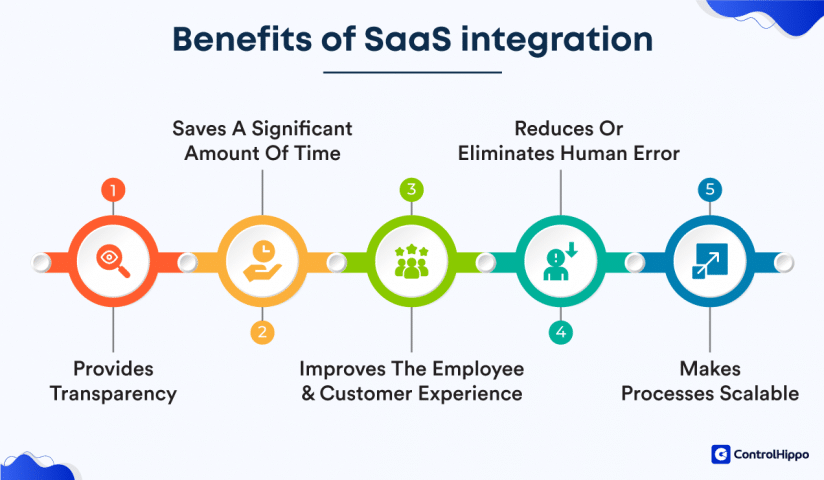Software as a Service (SaaS) integration partnerships are everywhere. If you’ve ever paid using PayPal in an app, used Grammarly in Gmail or Google Docs, or encountered any other situation where two or more software programs come together in a business relationship, you’ve seen an integration partnership.
Such integrations are quickly becoming pervasive online, helping tech companies fill gaps between their products and other products, grow their audiences, improve customer retention, and streamline the customer experience.
Integration partnerships have the potential to deliver huge value for tech companies. 95% of Microsoft’s revenue, for example, flows through its partnerships, while Shopify’s partner ecosystem generated over $6.9 billion in 2019.
This article will explore SaaS integration partnerships, their benefits, the value they can deliver to your business, and how you can begin finding technology partners.
What are integration partnerships?
Integration partnerships form when two or more SaaS companies connect, or integrate, their software solutions together to provide an enhanced user experience. The two software programs work together effortlessly to move data back and forth in real time, leading to streamlined workflows and a smoother customer experience.
When two software programs have formed an integration partnership, a user won’t need to hire a developer to connect their systems. Instead, it’s easy to connect the programs together without much technical experience.
How do integration partnerships work?
Integration partnerships are usually formed between two complementary products with distinct features. The products are connected in a way that lets the two programs communicate with each other. (Often, but not always, that’s through API – an application programming interface). The partners will then list each other’s offerings on their marketplace as integrating services.
Establishing valuable integration partnerships takes time. It requires two companies to properly connect their products so they communicate with, and pass information between, one another seamlessly.
Why should you form integration partnerships?
On average, only 28% of a company’s tech stack includes software that integrates with other tools. So, there’s an extremely valuable opportunity for forward-thinking firms to build extraordinary value through strategic partnerships with the right SaaS companies – those where an integration would deliver more user value.
Benefits of integration partnerships
One of the biggest benefits of establishing integration partnerships is that they allow companies to solve problems and add features without investing heavily in technology. These partnerships lend themselves to the realization of several other benefits, including:
- Improved customer satisfaction: Integration partnerships help enhance user experiences because your product meshes well with other complementary products. Customers will stick with you long-term when your integrations improve their experience and add to your product’s functionality. As a result, you’ll see a healthier customer lifecycle, where more customers move to the retention stage and may even recommend you to their peers.
- More growth potential: The improved customer satisfaction from integration partnerships can help you scale your business more quickly. Through the other business’ advertising their integrations with you, you gain the opportunity to reach a wider audience of highly qualified leads. Potential customers are likely to see that your software integrates with what they already use, and that they’ll be able to conveniently meet their current business needs by using it. This will lead to increased conversions.
- Boost your product offering: Integrating your software with a partner to offer additional features is much easier than engineering new features. Integration is particularly important to start-ups that want to scale their feature set but don’t necessarily have the capital to do so in-house. It’s much quicker to integrate with a partner than to develop features yourself (or outsource development within your own product).
- Develop industry relationships: Building industry relationships is key to achieving long-term growth, as it helps to create mutually beneficial alliances. By building a network of trusted partners, you can rely on each other for referrals, co-marketing campaigns, revenue sharing, and establishing integrations.
- Stand out from the crowd: Despite all the positives or integration partnerships, less than one-third of SaaS solutions and apps available today are integrated. Developing relationships with integration partners is one of the most effective ways to stand out against competitors without integrations.
Are you ready for an integration partnership?
Integration partnerships can deliver unparalleled value for SaaS companies. But that’s not to say that every SaaS operator is in a position to begin their foray into building them. There are indicators to show you’re ready for an integration partnership.
You’ll need an established product ready for an integration partnership, freely available to users and past any alpha, beta, and pre-release stages. You will also need the budget to invest in an integration with another company and, perhaps most importantly, the drive and willingness to maintain the partnership; it won’t be a one-and-done situation.
The best time to start an integration partnership is when you have the need for features that aren’t core to your product, but that would clearly enhance it, and that you’d benefit from having more urgently. As a rule, you’ll generally be ready for an integration partnership when organically looking to scale up your product with additional features or capabilities. Emphasis on organically; you shouldn’t be forcing things. Things should flow naturally. You need to be able to walk before you can run!
Finding integration partners
There are thousands of potential integration partners with complementary product offerings to your own. This number of potential partners is both a blessing and a curse; narrowing them down can be difficult.
It can take quite a while to research and select potential partners, and then you’ve got everything else to take care of: negotiation, agreements, and engineering. It’s safe to say that you won’t be deploying an integration overnight. You’ll therefore want a potential partner who will bring value and is just as dedicated as you to the cause.
When hunting for integration partners, consider the following:
- Do you share a target audience? Integration can only deliver value if it’s relevant to your customers. One of the biggest indicators of a solid potential partnership is the overlap between your customers and the customers of your potential partner.
- Will your customers use their features? There’s little point in going through the motions to develop a partnership when your customers have little to no use for your partner’s features. Don’t just establish ongoing partnerships for the sake of it; it’s better to pick a few partners with the most potential to improve your feature set.
- Will your partner benefit? Integration partnerships should be mutually beneficial arrangements. If you’re the only side gaining from a potential partnership, getting the other side on board may be challenging unless you offer substantial compensation.
- Do they already have an integration with one of your competitors? This could be a dealbreaker, but not always – it often pays to integrate with more established SaaS programs, even if competitors did first. This is especially true for integrations with leading providers, like CRMs, that many companies naturally have in their workflow.
Best practices for maintaining integration partnerships
The success of any partnership boils down to how well it’s managed. It’s not something you can work to set up and then forget about. Let’s look at a few best practices to help you establish and, more importantly, maintain positive partnerships.
Choose a partnership point of contact
It’s best to nominate one person as a single point of contact for managing each partner program. They’ll be responsible for running the partnership and managing the relationship with your partner. This choice helps to ensure a consistent, smooth approach conducive to positive relations.
As growth comes, consider putting together a dedicated partnerships team, with employees from your product, customer success, and marketing teams. However, you’ll still want to ensure that there’s one individual responsible for taking ownership of each partnership, even if they have a team supporting them.
Figure out monetization
Every successful partnership is formed because of the incentives each party has. No SaaS company will partner with you if they get nothing for their efforts, and you shouldn’t either. Incentives should appeal to your partner and increase in value as your partner generates more business.
One of the most impactful incentives is monetization, and there are many ways to achieve this.
- Will your partner get a share of revenue when people buy your software via the links on their site?
- Will they be able to offer their partners a discount, as long as they drive a certain amount of sales for you?
- Will higher amounts of sales unlock higher tiers of commissions?
You might also require your partner to invest in the partnership, to ensure that you get concrete benefits from the integration.
- Will partners need to commit resources with a clear value, such as designing an integration landing page, creating co-branded resources, or hosting webinars showcasing your integration?
Use PRM software
Partner relationship management (PRM) software is a vital collaboration solution for maintaining any integration partnership. This partner management system makes it easy to monitor the overall success of a partnership by creating unique tracking links. It also automates processes, and enables day-to-day management for both parties through a centralized portal.
PRM software can also incentivize potential partners by simplifying the end-to-end partnership process, making operations on both sides more efficient. With PRM software, you can combine co-marketing strategies, submit information about referrals, and develop an ecosystem where stakeholders can achieve full visibility into the partnership.
Write and sign a partnership agreement
Partnerships can only be successful when both parties are on the same page regarding expectations and requirements. The simplest and most effective way to do this is by creating a partnership agreement that both parties consent to.
In your partnership agreement, you should include information like the following:
- The duration of the agreement (if limited).
- Each party’s requirements for maintaining the integration.
- What features will each party supply to the other?
- Incentives and any commission structures.
- Grounds for termination (notice period to voluntarily stop the partnership, questionable activity that immediately terminates the partnership, etc.)
Onboard and train partners
Partner onboarding provides insight into your product, your customers, their problems, how you solve them, and what you expect from your partner’s team. When onboarding new partners, you need to do things like:
- Provide a comprehensive introduction.
- Explain how everything works (expectations, incentives, etc.)
- Introduce them to the partner portal/PRM software.
- Give an overview of the workings of your platform.
- Explain what resources are available to them (such as high-res images, or training docs to explain the integration to customers).
The idea of onboarding is to hit the ground running with a positive first impression, provide training, and help them get the most value from the partnership.
Hold regular check-in meetings
Along with onboarding and training, you’ll want to check in regularly with your partners. Take this time to look at the ROI being produced by the partnership, and review key performance metrics. Co-marketing opportunities (like webinars on your integrations or resources for customers) can be identified and presented, so reviewing sales and marketing plans is also essential during these meetings. And if the integration partnership isn’t performing how you expect, decide on a course of action together.
Be ready to invest in the upkeep
If you’re looking to scale your business using multiple partnerships, you’ll need resources to maintain them. Without the proper process, you risk spreading yourself too thin and damaging partner relationships.
As you do scale through partnerships, it’s crucial that your product team still has the support and time they need to focus on new developments and initiatives. You don’t want to detract from new features of your products by overburdening your product team with so many different integration partners.
Ready to find an integration partner?
Integration partnerships are an extremely valuable yet under-utilized way to generate organic growth for your SaaS company. By partnering with complementary businesses, you can benefit from increased exposure and access to new customers.
Before pursuing integration partnerships, it’s important to determine whether your business is ready for this type of collaboration. Once you have identified potential partners, establish best practices for maintaining successful partnerships, such as designating a partnership point person, regularly holding check-in meetings, and investing in the upkeep of your integration partnerships.
PRM software is the key to building strong integration partnerships when push comes to shove. Referral Rock’s world-class software automates every step of the process, allowing SaaS businesses to scale and measure the success of partnership programs.





